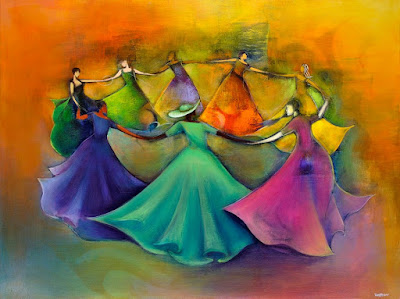 |
| The Circle Unbroken by Danny Broadway Studio |
Healing from trauma is also facilitated by rhythmic action shared with others, such as music, song and dance.1 In ancient Athens, Athena was celebrated with choral dance and song,2 and similar practices can still be witnessed today in traditional women’s circle dances of Greece and the Balkans. Through my lifetime of researching these dances in situ, I have come to believe these dances provide essential comfort and healing support for women who must live under patriarchal oppression.3
The dance circle itself is like Athena’s temple, the polis, the round enclosure within which the women are safe. To protect the city is to protect the city’s women, and this was Athena’s special domain: she was the guardian of the sacred space, the temple, the walled city or polis within which the women are kept secure.
I believe that traditional circle dances provide a context for women to affirm and transmit pre-patriarchal values, such as the importance of community, mutual support, and shared leadership, within a circular, not a hierarchical structure.4
The dances can help us both receive and give the gifts of protection and healing. Bessel van der Kolk affirms that ‘our capacity to destroy one another is matched by our capacity to heal one another,’5 and this experience of mutual healing is essential to healing from trauma.
The dances also show the importance of connecting with other women in shared rhythmic and joyful movement, and connecting with each other as allies instead of enemies. Ultimately we can learn to have compassion for ourselves, for each other, and for all those affected by the trauma of patriarchy, including the perpetrators.
Women of the world have been quietly screaming a shared scream for thousands of years. A new understanding of the ancient Goddesses, Athena, Metis, and Medusa, can help us realise that we are worthy of protection. Through distorted portrayals by patriarchal authors, all three of these Goddesses have suffered the trauma of ‘not being seen, not being recognized, and not being taken into account,’ but we can begin to change and heal this now, by seeing and understanding them more deeply in their original fullness and positivity.
Where Medusa’s head symbolises the fear, trauma, and uncontrolled rage experienced by those oppressed by patriarchal society, Athena’s original aspect of protection and healing can offer an antidote to the disempowerment, collapse and paralysis of the post-traumatic state. In this way Athena and Medusa can transcend the ancient enmity projected upon them by patriarchal authors and renew the alliance which protects and heals.
The Gorgoneion in the aegis gives protection by teaching us not to be afraid of our rage. By witnessing Medusa’s head with mindfulness, love and compassion, we can develop compassion for all victims of the trauma inflicted by patriarchy. Ultimately we hope to claim the power of our rage and outrage, and use it to protect and defend all that we hold dear.
Laura Shannon is considered one of the ‘grandmothers’ of the worldwide Sacred/Circle Dance movement, and has been researching and teaching traditional Greek, Balkan, and Armenian women’s dances for more than thirty years. Through seminars and trainings in twenty countries worldwide, Laura seeks to illuminate the inherently sacred and healing qualities of these women's ritual dances, and also explores the roots of women's circle dance in the Goddess cultures of Neolithic Old Europe as articulated by Marija Gimbutas.
Laura has been on the faculty of the Sacred Dance Department of the Findhorn Foundation since 1998, is Founding Director of the German non-profit Athena Institute for Women’s Dance and Culture, and in 2018 was chosen as an Honorary Lifetime Member of the Sacred Dance Guild in recognition of her 'significant and lasting contribution to dance as a sacred art'. Laura has university qualifications in Intercultural Studies, Dance Movement Therapy, and Myth, Cosmology and the Sacred, and is currently a PhD candidate in Dance and Religious Studies. She has published widely on women's sacred dance and writes a regular blog on feminismandreligion.com.
Laura is also a musician, and has produced or collaborated on numerous recordings of music for traditional dance. She divides her time between the UK and Greece, and is now teaching Women's Ritual Dances online via Zoom. In 2021 Laura succeeded Carol P. Christ as Director of the Ariadne Institute for the Study of Myth and Ritual, and from 2022 will be leading groups on the Goddess Pilgrimage to Crete following Carol's template. For more information, please visit www.laurashannon.net or Laura's page on academia.edu.
Notes
1 Van
der Kolk 2014:333.
2 Connelly
2007:29-30, 294.
3 Shannon
2011:144.
4 Shannon
2016.
5 Van
der Kolk 2014:38.
Comments
Post a Comment